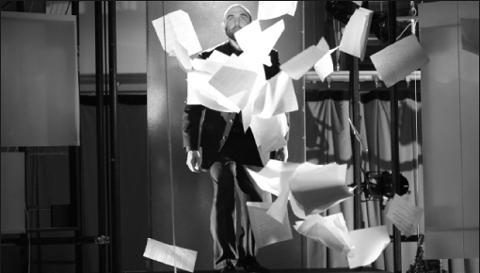By Will McKinley
What if there was more than one you?
That’s the thought-provoking premise of “Doppelganger,” the newest multimedia experiment at the 3LD Art and Technology Center. Combining high tech interactive scenic elements with a reality-bending narrative, “Doppelganger” tells the strange story of three Toronto office workers whose lives intersect when one of them jumps 40 stories to his death. Or does he?
The show opens with Frank, a black-suited corporate shark obnoxiously challenging George, a nebbishy co-worker, to be more of a risk-taker. “This world doesn’t offer second chances,” Frank preaches to his bespectacled, sweater vest-wearing colleague.
Frank is having a reckless affair with Marcia, a high-powered human resources executive whose insecurities are masked by a power skirt and nosebleed pumps. Frank and Marcia like to engage in loud lovemaking up against the glass in the windowed conference room of their high-rise office. One of these charming romantic interludes is witnessed by George, through a pair of binoculars, from a neighboring building.
Now here’s where it gets weird. Frank is in both places at the same time. He’s bending George’s ear in one building and dictating Marcia’s brains out in the other one. Then one of the Franks has an orgasm with one of the Marcias and the other Frank jumps out the 40th floor window and splatters on the ground below — and all over the other Marcia’s dress. And that’s just the first ten minutes of the show.
For the next hour, characters from both realities inter-mingle, Marcia is strapped to a table like the Bride of Frankenstein, George goes on a mind-bending acid trip, and at least one other person dies. Or comes to life, depending on your perspective.
If all of that confuses you, you’re not alone. “Doppelganger” is a play like “Twin Peaks” was a TV show. There’s a beginning and an end, but what happens in between is a stylish head scratcher. Playwright Simon Heath’s story suggests that there are concurrent worlds to our own, where our lives follow similar yet entirely different storylines. And, as one character says, “the two realities are united at our death.”
Dude. That is deep. It’s also a bit over-done.
The concept of parallel time and alternate reality has been explored in countless TV shows and movies — everything from creepy classics like “The Twilight Zone” and “Dark Shadows” to more recent film fantasies like “Sliding Doors” and “The Double Life of Veronique.” But director Manny Bocchieri effectively meets the challenges of presenting a familiar story with inventive style.
The on-stage action is confined to an all-purpose single set that represents offices, conference rooms, an apartment, a sleep lab and probably a few other things that I didn’t catch. A spiderwork of 18 projection screens of varying sizes hangs from the ceiling, providing a visual representation of the inner psychic turmoil of the characters. Esoteric images like PowerPoint slides, moving lips and vintage cartoons fill the screens, and sound and video cues are triggered by the individual performer’s interaction with the physical set pieces. The result is a daft dream world that encourages the viewer to play along with the convoluted but engaging narrative.
The cast, including Jermaine Chambers as George, Heather Carmichael as Marcia and Matt Hanley as Frank, is uniformly solid, and Metha Brown is a standout as a malevolent psychoanalyst ominously known as The Doctor. (“Sensitivity is not my strong point,” she tells a panicky patient.)
“Doppelganger” is a production of the Feed the Herd Theatre Company, the first in 3-Legged Dog’s curated artist residency program. The creative team seems to understand the commitment that the mad scientists at 3LD have for merging technology with thoughtful live theater, and the result of their partnership is the most accessible show that 3LD has staged this year.
“Doppelganger” achieves its greatest success when the twisty-turny narrative tunes in to the frequency of the audience’s imagination, a moment of transcendence that happens infrequently in traditional theater. The show often misses the mark, and arguably it under-utilizes some potentially revolutionary scenic elements. But when “Doppelganger” works — when the story, the actors, the video screens, the audio snippets and the interactive set come together into one dreamlike whole — the show evokes a Lynchian world where everything is completely mundane and totally trippy at the exact same moment.
The only thing that’s missing is the dancing midget in the red suit.
































